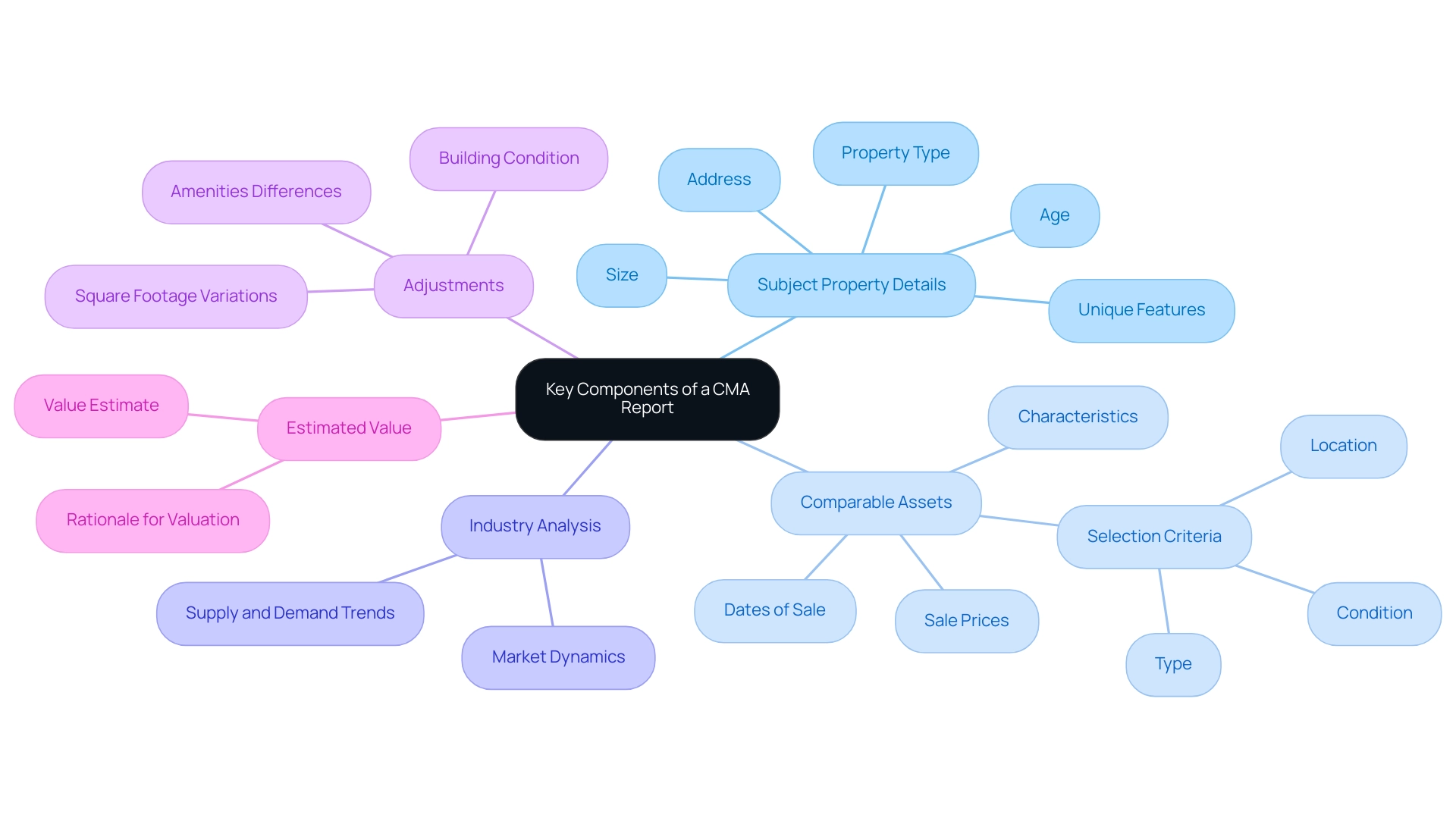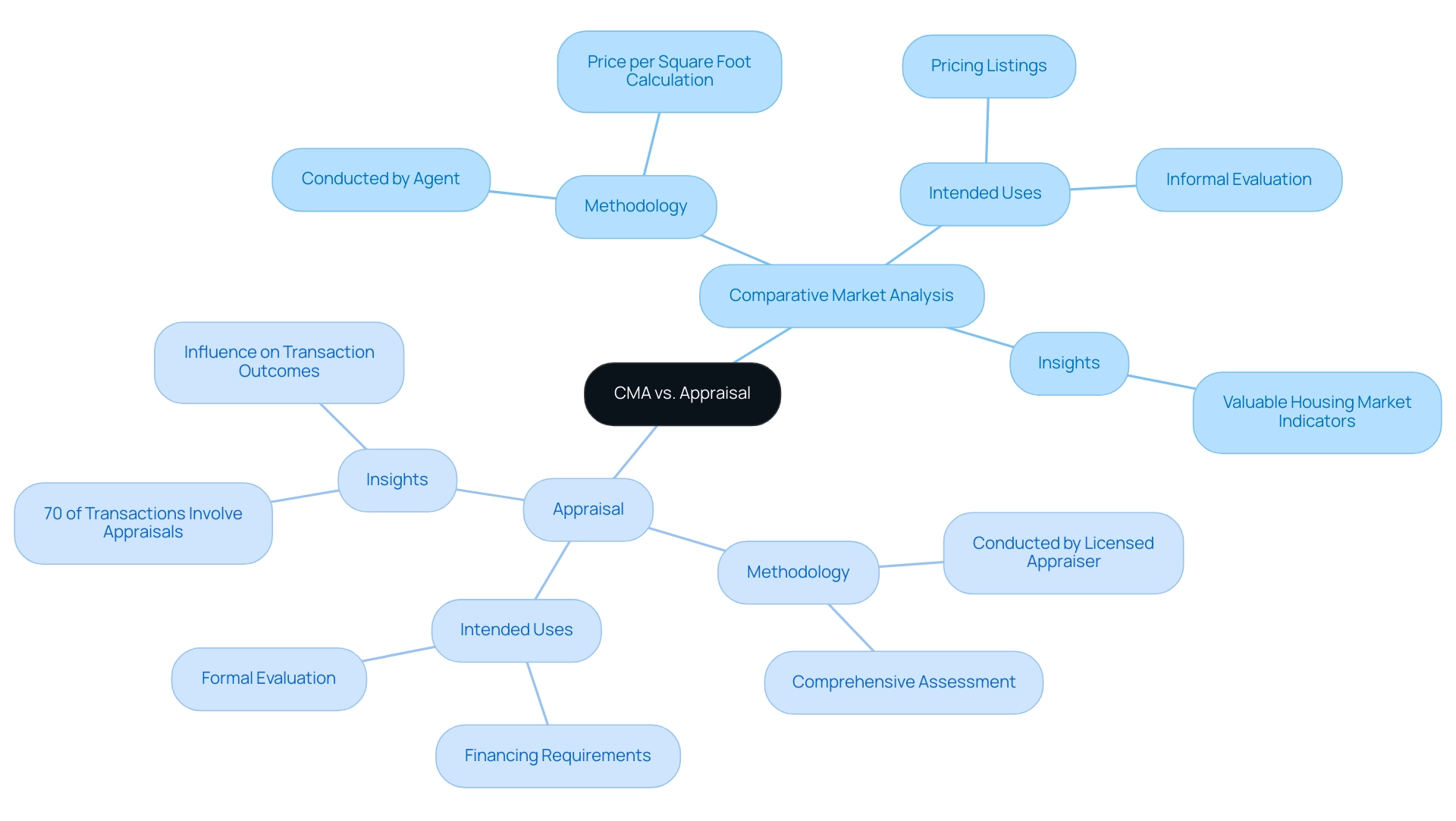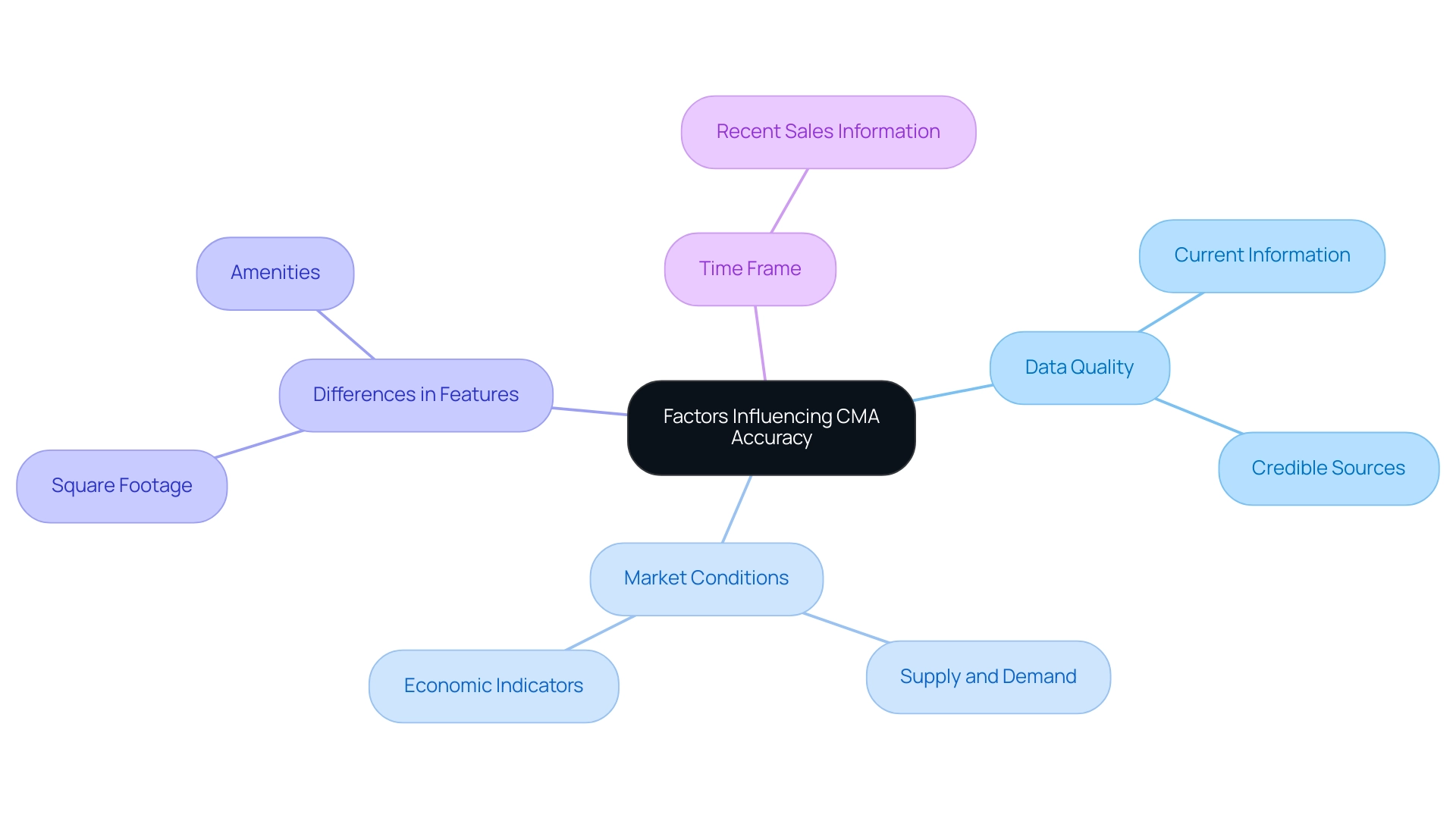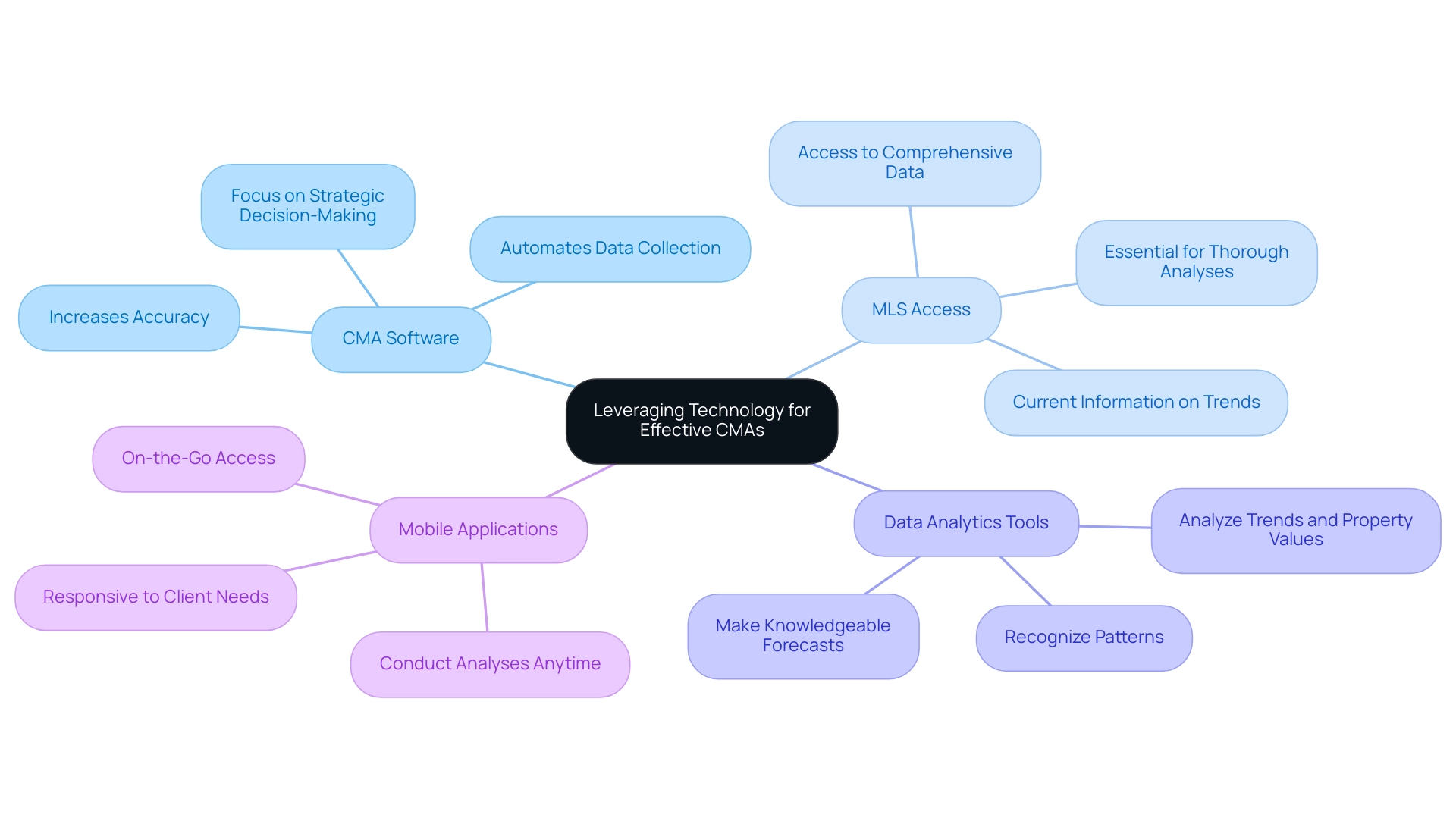Overview
A comparative market analysis (CMA) in real estate serves as a crucial instrument for determining property values. By evaluating recently sold comparable homes, it empowers both buyers and sellers to make informed decisions. A well-executed CMA not only establishes competitive listing prices but also enhances negotiation strategies. This ultimately leads to more successful transactions by providing data-driven insights into market trends and property valuations. The implications for investors are significant; leveraging a CMA can result in better investment outcomes and a stronger position in negotiations.
Introduction
In the intricate world of real estate, grasping the true value of a property is essential for both buyers and sellers. Enter the Comparative Market Analysis (CMA), a powerful tool that real estate professionals depend on to evaluate property values through recent sales data from comparable homes in the area.
By meticulously analyzing factors such as:
- location
- size
- amenities
CMAs empower agents to establish competitive listing prices while enabling buyers to make informed offers. With approximately 85% of real estate professionals employing this method, the importance of CMAs in facilitating successful transactions cannot be overstated.
As the industry evolves, leveraging advanced data analytics and technology in the CMA process is increasingly vital, ensuring that real estate stakeholders remain well-informed in a dynamic market landscape.
Understanding Comparative Market Analysis (CMA)
A comparative market analysis (CMA) in real estate serves as an indispensable tool for realty professionals, enabling them to assess a residence's value by scrutinizing recently sold, similar homes within the same area. This method entails a comprehensive evaluation of various factors, such as location, size, condition, and amenities, to derive an accurate market value. By analyzing these comparable properties, agents can furnish a data-driven estimate that is essential for both buyers and sellers, thereby facilitating informed decision-making in real estate transactions.
Current statistics reveal that approximately 85% of real estate professionals employ comparative market analysis for valuation purposes, underscoring its pivotal role in the industry. CMAs not only assist sellers in comprehending the value of their assets but also guide buyers in adjusting their budgets accordingly. For example, a meticulously executed CMA can unveil trends in property values, empowering agents to recommend competitive listing prices that attract potential buyers.
It is crucial to distinguish that appraisals are formal value assessments conducted by licensed professionals, mandated by lenders for mortgage applications. While CMAs provide significant insights for asset valuation, they do not constitute official assessments.
A notable case study illustrates the efficacy of CMAs in a competitive landscape. In a recent transaction, an agent leveraged a CMA to justify a listing price that was 10% higher than the average value based on comparable sales. This strategic approach not only culminated in a successful sale but also highlighted the agent's expertise in navigating industry dynamics, reinforcing the importance of comparative market analysis in enhancing negotiation strategies.
Key factors assessed in a CMA encompass the property's square footage, the number of bedrooms and bathrooms, and the overall condition of the home. Additionally, the analysis considers current occupancy rates and industry trends at both local and hyperlocal levels, providing a thorough overview of the real property landscape.
As we look ahead to 2025, the latest trends in comparative market analysis emphasize the integration of advanced data analytics and technology, facilitating more accurate valuations and insights. Real property professionals are increasingly harnessing these tools to refine their CMA processes, ensuring they remain competitive in a rapidly evolving market.
In conclusion, a well-executed comparative market analysis is not merely a formal appraisal; it is a vital component of the real property transaction process that empowers all parties involved. By concentrating on factual data and market trends, CMAs enhance decision-making and negotiation strategies, ultimately leading to more successful outcomes in real estate dealings. Negotiating sale prices also involves considering concessions, further illustrating the significance of CMAs in the negotiation process.
The Importance of Conducting a CMA
Conducting a comparative market analysis in real estate is essential for several compelling reasons. For sellers, a well-executed comparative market analysis aids in establishing a competitive listing price that attracts potential buyers while maximizing their return on investment. Research indicates that assets priced accurately based on comparative market analysis data tend to sell faster and closer to their asking price, significantly enhancing seller satisfaction.
For purchasers, a comparative market analysis serves as a crucial standard to evaluate whether a residence is fairly priced. By analyzing comparable properties that have sold within the last 3 to 6 months, buyers can make informed offers, ensuring they do not overpay for their desired home. This timeframe is vital for ensuring comparability, particularly in a fluctuating environment where pricing can vary widely.
Real property agents also rely heavily on comparative market analysis to navigate the complexities of the buying and selling process. By utilizing factual data rather than assumptions, agents can provide their clients with sound advice, ultimately leading to more successful transactions. The adoption of tools like the Matrix CMA in 2010 exemplifies this trend, as it streamlined the process for brokers, allowing them to create detailed, professionally formatted presentations that enhance communication with clients.
The Matrix CMA featured mapping capabilities that enabled customized searches, further improving the quality of client presentations.
Furthermore, statistics indicate that properties with a well-researched comparative market analysis are more likely to achieve listing prices that reflect current economic conditions. This is vital in 2025, as the real property landscape continues to evolve, making the significance of conducting a CMA more pronounced than ever. As Victoria Araj notes, "The first step for an agent preparing a CMA is to find three homes that have sold recently, preferably within the past three months."
In summary, the benefits of conducting a comparative market analysis extend beyond mere pricing; they empower both sellers and buyers with the insights needed to make informed decisions in the real estate market. CMA presentations have evolved to include comprehensive asset information and sophisticated statistical data, further enhancing their effectiveness in today's dynamic environment.
Step-by-Step Process for Conducting a CMA
- Gather Data on Your Subject Asset: Initiate your analysis by collecting comprehensive details about the asset in question. This encompasses its location, size, age, and any unique features that could impact its market value. Accurate data collection is paramount, as it lays the groundwork for your analysis.
- Research the Market: Dive into the recent sales of real estate in the vicinity that are comparable to your subject asset. Strive to identify at least three to five similar listings (comps) that have sold within the last three to six months. This timeframe is crucial for accurately reflecting current market conditions.
- Select Comparable Assets: Choose comps that closely match your subject asset in terms of size, location, and condition. The closer the alignment, the more reliable your analysis will be. This selection process is essential for ensuring that your comparisons are both valid and relevant.
- Analyze the Data: Carefully examine the sale prices of the selected comparable assets, making necessary adjustments for any differences. For example, if a comp has an additional bedroom or a larger lot size, adjust its price to account for these variances. This step is critical for achieving an accurate valuation.
- Calculate the Average Price: Determine the average price per square foot of the comparable real estate. It is advisable to use at least three closed sales within the last 0 to 12 months for a Comparative Market Analysis (CMA) to ensure a robust analysis. This figure will serve as a benchmark for estimating the value of your subject asset.
- Prepare the CMA Report: Compile your findings into a detailed report that includes information about the subject site, the comparable sites, and your analytical insights. This report will not only facilitate discussions with clients but also enhance your credibility as a knowledgeable property expert.
Recent advancements in CMA processes, such as the adoption of the Matrix MLS database by NWMLS in 2010, have introduced tools like CMA wizards and mapping features. These innovations streamline the creation of detailed presentations and customized searches related to listings, further enhancing the accuracy and efficiency of conducting a CMA. As Andrew Wan, a licensed broker, emphasizes, 'Once you’ve collected this data, I also strongly advise an in-person visit to the site to see if there are any notable discrepancies.' This firsthand evaluation is vital for ensuring the accuracy of your analysis.
The evolution of CMA presentations from basic reports to comprehensive analyses underscores the growing complexity and importance of thorough CMA reports in today’s real estate landscape.
Key Components of a CMA Report
A well-structured Comparative Market Analysis (CMA) report is crucial for accurately assessing property values and should encompass the following key components:
- Subject Property Details: This section provides comprehensive information about the subject property, including its address, property type, size, age, and any unique features that may influence its market value. Clear documentation of these details sets the foundation for the analysis.
- Comparable Assets: A critical aspect of the CMA is the selection of comparable assets (comps). This list should include assets that have recently sold, ideally within the last three to six months, along with their sale prices, dates of sale, and relevant characteristics. The effectiveness of a comparative market analysis in real estate hinges on the careful selection of these comps, as they directly impact the accuracy of the valuation. For instance, a case study titled "Criteria for Selecting Comparable Assets" highlights that agents who meticulously choose comps based on factors such as location, type, and condition can make precise price adjustments, leading to more accurate valuations.
- Industry Analysis: This component provides insights into current trends, including supply and demand dynamics in the area. Understanding these trends is essential for homeowners to set appropriate asking prices and for buyers to negotiate competitive offers. Recent data indicates that a well-informed comparative market analysis in real estate can significantly influence the success of a transaction, as it is essential for determining appropriate asking prices and negotiating competitive offers.
- Adjustments: In this section, any modifications made to the comparable assets should be detailed to account for differences that may affect value. This could include variations in square footage, amenities, or building condition. By transparently documenting these adjustments, the CMA enhances its credibility and provides a clearer rationale for the estimated value.
- Estimated Value: Ultimately, the report should conclude with a clear estimate of the subject asset's value based on the analysis, accompanied by a rationale for this valuation. This estimate serves as a guiding figure for pricing strategies and negotiations, making it a pivotal element of the CMA.
Incorporating these components into a comparative market analysis in real estate not only aids in establishing a market value but also empowers real estate professionals to make informed decisions. As industry expert Victoria Araj, who has over 19 years of experience with Rocket Mortgage, emphasizes, the initial step in preparing a CMA is to identify three recently sold homes that closely resemble the subject residence, underscoring the importance of thorough research in this process.

CMA vs. Appraisal: Key Differences
While both a Comparative Market Analysis (CMA) and an appraisal aim to determine the worth of an asset, they differ significantly in methodology and intended use. A Comparative Market Analysis in real estate is typically conducted by a real estate agent, relying on recent sales information of similar homes to establish a reasonable value. This informal evaluation is primarily utilized for positioning listings competitively, enabling sellers to price their assets effectively in the market.
A crucial aspect of this process is calculating price per square foot, which helps confirm the final estimate and provides a check against overall industry trends.
In contrast, an appraisal is conducted by a licensed appraiser, signifying a more formal and comprehensive assessment of an asset's value. Appraisals are frequently required for financing purposes and entail a thorough examination that considers a wider array of elements, including the asset's condition, location, and prevailing market trends. For instance, a recent case highlighted that a buyer offered $1.92 million on a property listed at $1.8 million, showcasing how precise evaluations can influence transaction outcomes.
Understanding the differences between appraisals and Comparative Market Analysis in real estate is crucial for property professionals. CMAs are often referred to as informal appraisals, providing valuable housing market indicators before a contract is signed, while appraisals occur post-contract and serve as a definitive assessment of value. According to industry insights, approximately 70% of real property transactions involve appraisals, underscoring their significance in the buying and selling process.
Both appraisals and Comparative Market Analysis in real estate play essential roles in transactions, yet they serve distinct purposes. CMAs are best utilized for setting competitive prices, while appraisals provide a legally recognized valuation necessary for securing financing. As Robertson aptly noted, "As I’ve heard many times, Zillow can’t smell the cat or hear the dog bark," emphasizing the limitations of automated valuation models and the importance of professional evaluations.
By understanding when to use each tool, property investors can make informed decisions that align with their investment strategies.

Factors Influencing CMA Accuracy
Several critical factors significantly influence the accuracy of a Comparative Market Analysis (CMA) in real property:
- Data Quality: The foundation of a reliable CMA lies in the quality of the data used for comparables. Accurate and current information is essential; outdated or incorrect data can lead to misleading conclusions that adversely affect investment decisions. Statistics Canada emphasizes this point, stating their commitment to serving clients with reliable data, underscoring the importance of sourcing information from credible outlets. A study highlights that the precision of data directly relates to the effectiveness of comparative market analysis in real estate, reinforcing the necessity for high-quality data in CMAs.
- Market Conditions: Current market trends play a pivotal role in determining asset values. Factors such as shifts in supply and demand, interest rates, and economic indicators can all influence the property market. Recent simulations demonstrate that comprehending these dynamics is essential for obtaining precise results in comparative market analysis, as they mirror the real-time conditions influencing real estate sales.
- Differences in Features: When performing a CMA, it is crucial to adjust for variations in features. Differences in square footage, condition, location, and amenities must be accounted for to ensure a fair comparison. Neglecting these differences can skew results and lead to inaccurate valuations. Real estate experts stress that careful modifications are essential for an accurate comparative market analysis to represent the actual value of assets. For instance, the CMAQ Model Disk Space Management study illustrates how managing data precision can significantly impact analysis outcomes, suggesting that similar principles apply to CMA accuracy.
- Time Frame: The timeframe of the sales data is another critical element. Using comparables that are outdated may not accurately reflect current conditions, resulting in possible miscalculations in asset value. Analysts suggest focusing on recent sales information to identify the latest trends and changes in the industry.
Integrating these elements into your comparative market analysis process not only enhances the precision of your analysis but also allows you to make informed choices in a fluctuating environment. By prioritizing data integrity and staying attuned to market dynamics, investors can navigate the complexities of asset valuation with greater confidence.

Leveraging Technology for Effective CMAs
Technology is revolutionizing the comparative market analysis real estate process, equipping real estate professionals with powerful tools that enhance efficiency and accuracy. Here are several key ways to leverage technology effectively:
- CMA Software: Implement specialized CMA software that automates data collection and analysis. This not only accelerates the process but also increases accuracy, allowing professionals to focus on strategic decision-making rather than manual data entry. Zero Flux's commitment to factual information empowers subscribers to make informed decisions, which is crucial for utilizing these tools effectively.
- MLS Access: Utilize Multiple Listing Service (MLS) databases to access a wealth of comprehensive data on similar listings. This resource is invaluable for obtaining current information on trends and asset values, essential for conducting thorough analyses.
- Data Analytics Tools: Employ advanced data analytics tools to analyze trends and property values. These tools provide deeper insights, enabling realty professionals to recognize patterns and make knowledgeable forecasts about future trends in the industry. For instance, job postings for climate technologies beyond electrification changed by -11% from 2022 to 2023, reflecting the evolving landscape that property professionals must navigate.
- Mobile Applications: Explore mobile applications that facilitate on-the-go access to CMA tools and data. This flexibility empowers real professionals to conduct analyses anytime and anywhere, ensuring they remain responsive to client needs and market changes.
As Mena Issler, an associate partner, notes, 'The integration of technology in comparative market analysis real estate processes not only streamlines operations but also enhances the overall effectiveness of property professionals.' The integration of these technologies not only streamlines the comparative market analysis real estate process but also enhances the overall effectiveness of property professionals. As the industry continues to evolve, staying abreast of the latest technology trends in comparative market analysis real estate software usage will be crucial for maintaining a competitive edge.

Using CMAs to Inform Real Estate Investment Decisions
Real estate investors can leverage Comparative Market Analyses (CMAs) to enhance their investment strategies in several impactful ways:
- Identifying Opportunities: CMAs are instrumental in pinpointing undervalued properties that present strong investment potential. By examining comparative pricing, investors can discover hidden gems in the industry that may not be immediately apparent.
- Setting Offer Prices: Utilizing comparative market analysis real estate data allows investors to establish competitive offer prices when bidding on properties. This ensures that offers are based on factual data, increasing the likelihood of successful negotiations.
Regularly conducting a comparative market analysis equips investors with the latest insights into trends. This continuous examination is essential for making prompt choices concerning real estate acquisitions or sales, especially in a dynamic economic environment.
- Risk Assessment: Comparative market analysis provides a wealth of data that can be analyzed to assess the risks associated with specific investments. By understanding market dynamics and real estate valuations, investors can make more informed decisions, ultimately leading to better investment outcomes.
Statistics indicate that a significant percentage of investors—over 70%—utilize comparative market analysis to identify undervalued properties, highlighting their critical role in the investment process. Furthermore, case studies illustrate the success of data-driven approaches in property investment. For instance, companies like Springboard have demonstrated that tailored data solutions can help investors reduce costs, enhance productivity, and improve returns through informed decision-making.
Incorporating expert opinions into the investment strategy can also be beneficial. Many seasoned investors emphasize the value of comparative market analysis in identifying lucrative investment opportunities. As one investor noted, "I came to the US with seven dollars to my name. Over time, after years of learning, I was able to expand my property portfolio to over 7,500 units!" This illustrates the potential for substantial portfolio growth through informed investment decisions, echoing the sentiment that informed decisions are key to success in real estate investing. Furthermore, with lower interest rates typically making mortgages more affordable, investors can capitalize on favorable conditions.
By integrating comparative market analysis into their investment strategies, investors can navigate the complexities of the market with greater confidence and precision. Zero Flux, as a leading authority in real estate information dissemination, emphasizes the importance of data integrity and sourcing from credible outlets, further supporting the argument for using comparative market analysis in investment strategies.
Conclusion
Understanding the significance of a Comparative Market Analysis (CMA) is crucial for anyone involved in real estate transactions. CMAs provide a systematic approach to assessing property values by analyzing recent sales of comparable homes, considering factors such as location, size, and amenities. This process not only aids sellers in setting competitive listing prices but also empowers buyers to make informed offers, ensuring a fair market value is established.
The increasing reliance on CMAs by real estate professionals—approximately 85% of agents utilize this tool—underscores its pivotal role in facilitating successful property transactions. As the real estate landscape continues to evolve, the integration of advanced data analytics and technology into the CMA process enhances its effectiveness, allowing for more precise valuations and insights. This technological advancement ensures that all stakeholders remain well-informed in a dynamic market environment.
Ultimately, a well-executed CMA serves as an invaluable resource that drives better decision-making and negotiation strategies. By focusing on accurate data and current market trends, CMAs not only help in achieving favorable sale prices but also contribute to overall satisfaction for both buyers and sellers. As the industry progresses, the importance of conducting thorough CMAs will only grow, making it an essential practice for anyone looking to navigate the complexities of real estate successfully.




